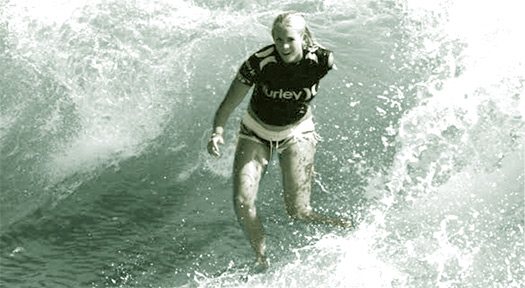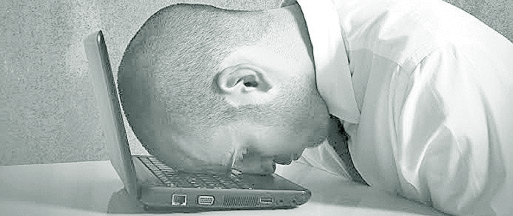Success is the result of learning from failures
By Lionel Wijesiri
Bethany Meilani Hamilton, 24-year old American professional surfer
always fascinated me. I regard her as an extraordinary woman who
overcame her serious disability to live not just independently but a
rich, fulfilling life. Today, her story has become a role model for
anyone seeking true meaning to a positive approach in life. On October
31, 2003, at age 13, Bethany went for a morning surf along Tunnels
Beach, Hawaii, with her best friend Alana Blanchard and Alana’s father
and brother. Around 7:30 in the morning with numerous turtles in the
area, she was lying on her surfboard with her left arm dangling in the
water, when a 15-foot tiger shark attacked her, severing her left arm
just below the shoulder. The Blanchards helped paddle her back to shore.
|

Bethany Hamilton, the professional surfer who lost an arm in
a shark attack when she was just 13 years, never lost
courage to fight back |
Then Alana’s father fashioned a tourniquet out of a surfboard leash
and wrapped it around the stump of her arm, before she was rushed to
Hospital. By the time she arrived there she had lost over 60 percent of
her blood and was in hypovolemic shock. She underwent surgery and had to
spend a week in recovery before being released.
Despite the trauma of the incident, Bethany was determined to return
to surfing. Less than a month after the incident, she returned to her
board. Initially, she adopted a custom-made board that was longer and
slightly thicker than standard and had a handle for her right arm,
making it easier to paddle, and she learned to kick more to make up for
the loss of her left arm. After teaching herself to surf with one arm,
on January 10, 2004, she entered a major competition. A little over a
year later, she won her first national title. Between 2005 and 2009, she
entered 10 major competitions and won four times between first and third
places.
On March 20 this year, she won the Surf N Sea Pipeline Women’s Pro, a
major event in women’s surfing held at the Banzai Pipeline, a surf reef
in Hawaii. In 2004 she wrote about her experience in her autobiography
Soul Surfer: Fighting to Get
Back on the Board. This was made into a feature film - Soul Surfer,
which was released in 2011.There were two more documentaries made about
her life. She has appeared on many television shows since the loss of
her arm. Rejection Reading Bethany’s story, I often wonder how failure
shatters most of us and how much we panic even though we have an
inherent strength to overcome the fear.
Remember how we learnt walking and cycling? Falling several times
while learning how to walk and peddle was common. But ironically from
our childhood days we are made to believe that winners get the rewards
and losers are jeered. Some of the world’s most successful people have
failed - sometimes more than once.
Like Bethany, there are numerous examples of celebrities,
sportspersons, actors, authors and leaders who in spite of facing defeat
did not give up on their dreams. They succeeded in overcoming their fear
of failure.
Steve Jobs was fired from his own company; Warren Buffet was rejected
by Harvard University, Richard Branson is a high school drop-out,
Abraham Lincoln lost eight elections and Thomas Edison, failed more than
1,000 times when trying to create the light bulb.
Oprah Winfrey was fired from her first television job as an anchor.
Walt Disney was fired by a newspaper editor because he “lacked
imagination and had no good ideas.”
Steven Spielberg was rejected by the University of Southern
California School Of Cinematic Arts many times.
In Sri Lanka, nearly 30,000 government troops were injured during the
last three years of our 30-year war with terrorists. Most of them are
returning to the society to live in that same dignified manner. They
play games. They are employed productively in different workplaces. For
example, two progressive apparel factories are run entirely by
‘disabled’ soldiers. Their struggle to return to independent lifestyles
proves that their hearts are mightier than ours. The disasters did not
keep these great people away from achieving their goals and becoming
extra-ordinarily successful.
Focus on failure
The sad part is, many of us avoid the prospect of failure. We are so
focused on not failing that we do not aim for success, settling instead
for a life of mediocrity. When we do take missteps, we gloss over them,
selectively editing out the miscalculations or mistakes in our life’s
résumé.
Of all the things we are wrong about, this idea of error might well
top the list. We are wrong about what it means to be wrong. Far from
being a sign of intellectual inferiority, the capacity to err is crucial
to human cognition.
New trend
Fortunately, in the business field, thinking has begun to change. In
today’s cash-strapped-business environment, some employers are no longer
shying away from failure - they’re embracing it. I have read a recent
article in BusinessWeek, which says that many companies are deliberately
seeking out those with track records reflecting both failure and
success, believing that those who have been in the trenches, survived
battle and come out on the other side have irreplaceable experience and
perseverance. They’re veterans of failure.
|

Failure is a good thing on the field or workplace. Failure
is a part of the life and all intelligent people will accept
it and move on... |
The same holds true for personal quests, whether in overcoming some
specific challenge or reaching your full potential in all aspects of
life. To achieve your personal best, to reach unparalleled heights, to
make the impossible possible, you can’t fear failure, you must think
big, and you have to push yourself.
Worth the risk
When the rewards of success are great, embracing possible failure is
key to taking on a variety of challenges, whether you’re reinventing
yourself by starting a new business or allowing yourself to trust
another person to build a deeper relationship.
The other day, I was reading the life-story of legendary aviator
Amelia Earhart. She was an American aviation pioneer and author. Earhart
was the first female aviator to fly solo across the Atlantic Ocean. She
received the U.S. Distinguished Flying Cross for this record.
She set many other records, wrote best-selling books about her flying
experiences and was instrumental in the formation of The Ninety-Nines,
an organisation for female pilots. During an attempt to make a
circumnavigation flight of the globe in 1937 in a Lockheed Model 10
Electra, Earhart disappeared over the central Pacific Ocean. Although
her final flight proved fateful, her contemporaries believe she knew the
risk - and decided that the potential reward was worth it. Earhart’s
advice when it came to risk was simple and direct: ‘Decide whether or
not the goal is worth the risks involved. If it is, stop worrying.”
Of course, the risks you take should be calculated; you shouldn’t fly
blindly into the night and simply hope for the best. Achieving the goal
or at least waging a heroic effort requires preparation, practice and
some awareness of your skills and talents. Fear of failure You fail. I
fail.
The best of us fail, and the rest of us fail, too. Those who never
rise from a fall often see failure as final. What we all need to
remember is that life is not a pass-fail test. It is a trial and error
process. Those who succeed bounce back from their bonehead mistakes
because they view their setbacks as temporary and as learning
experiences. Winston Churchill captured the essence of it when he said,
“success is the ability to go from one failure to another without no
loss of enthusiasm”. |

